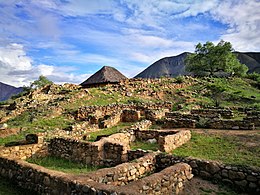This article includes a list of general references, but it lacks sufficient corresponding inline citations. (May 2009) |
Huánuco (Spanish pronunciation: [ˈwanuko]; Quechua: Wanuku) is a city in central Peru. It had a population of 196,627 as of 2017[2] and in 2015 it had a population of 175,068. It is the capital of the Huánuco Region and the Huánuco District. It is the seat of the diocese of Huánuco. The metropolitan city of Huanuco is 170,000 hab (2011, urban pop, INEI). It has three districts, Huanuco (head), Amarilis, and Pillco Marca. In this city, the Higueras river meets the Huallaga river, one of the largest rivers in the country.
Huánuco
Wanuku Caballeros del León de Huánuco | |
|---|---|
Top:San Sebastian Church and Huanuco San Sebastian Park, Second:Calicaoto Bridge and Huallagu River, A street of July 28 Merced Passage of Huanuco, Third:Huanuco Carthedral and Almas Square, Huanuco Saint Domingo Park, Bottom:Kotosh Ruin and Kotosh Temple of the Crossed Hands (all item of left to right) | |
| Coordinates: 9°55′46.07″S 76°14′22.97″W / 9.9294639°S 76.2397139°W | |
| Country | |
| Region | Huánuco |
| Province | Huánuco |
| Founded | 15 August 1539 |
| Founded by | Gómez de Alvarado y Contreras |
| Government | |
| • Mayor | José Luis Villavicencio Guardia (2019-2022) |
| Elevation | 1,880 m (6,170 ft) |
| Population (2017) | |
• Total | 196,627 |
• Estimate (2015)[1] | 175,068 |
| Demonym | huanuqueño/a |
| Time zone | UTC-5 (PET) |
History
editThe city of Huánuco was founded by Spanish conquistador Gómez de Alvarado in 1539,[3] in the Inca town of the Yarowilca clan, Wanako. In 1541, the city was moved to its current location in the Pillco Valley.
The indigenous chronicler Juan de Santa Cruz Pachacuti Yamqui Salcamaygua notes that during the Inca Empire, Pillco was a significant source of Aclla nuns for the capital city of Cusco, stating, "...there were maidens from all nations, especially from three, namely: Cusco and its territory, the Chachapoyas, and Pillco, which they now call Guánuco."[4]
Huánuco was the scene of one of the Chilean massacres during their occupation of Peruvian territory from 1881 to 1883.[3]
Geography
editClimate
editHuánuco has a mild semi-arid climate (Köppen BSh). The temperatures are pleasant throughout the year with very warm days and comfortable nights due to its elevation of 1,913 metres or 6,276 feet.
| Climate data for Huánuco, elevation 1,919 m (6,296 ft), (1991–2020) | |||||||||||||
|---|---|---|---|---|---|---|---|---|---|---|---|---|---|
| Month | Jan | Feb | Mar | Apr | May | Jun | Jul | Aug | Sep | Oct | Nov | Dec | Year |
| Mean daily maximum °C (°F) | 26.1 (79.0) |
26.0 (78.8) |
25.9 (78.6) |
26.8 (80.2) |
27.1 (80.8) |
26.5 (79.7) |
26.2 (79.2) |
26.7 (80.1) |
27.0 (80.6) |
27.0 (80.6) |
27.0 (80.6) |
26.2 (79.2) |
26.5 (79.8) |
| Mean daily minimum °C (°F) | 15.3 (59.5) |
15.4 (59.7) |
15.2 (59.4) |
14.8 (58.6) |
13.9 (57.0) |
12.6 (54.7) |
11.7 (53.1) |
12.5 (54.5) |
13.9 (57.0) |
14.9 (58.8) |
15.6 (60.1) |
15.2 (59.4) |
14.3 (57.7) |
| Average precipitation mm (inches) | 53.1 (2.09) |
59.0 (2.32) |
76.9 (3.03) |
34.4 (1.35) |
11.7 (0.46) |
5.5 (0.22) |
4.1 (0.16) |
6.7 (0.26) |
12.9 (0.51) |
43.5 (1.71) |
50.0 (1.97) |
70.0 (2.76) |
427.8 (16.84) |
| Source: National Meteorology and Hydrology Service of Peru[5] | |||||||||||||
Education
editSchools
editUniversities
editNotable people
edit- Mariano Ignacio Prado - President and General, born in 1825.
- Leoncio Prado - Colonel and hero; fought in Cuba and against the Chilean invasion after The War of the Pacific.
- Javier Pulgar Vidal - Famous geographer, born in Panao Province.
- Daniel Alomía Robles - Musical composer and ethnologist born in 1871, famous for El Cóndor Pasa
- Johan Fano- Professional football player
- Beker Fabian - poet and writer
Transportation
editIt is served by the Alférez FAP David Figueroa Fernandini Airport. One of the main highways of the country passes by Huanuco, connecting Lima-Callao with Tingo Maria and Pucallpa in the Peruvian Amazonia.[citation needed]
See also
editNotes
edit- ^ Perú: Población estimada al 30 de junio y tasa de crecimiento de las ciudades capitales, por departamento, 2011 y 2015. Perú: Estimaciones y proyecciones de población total por sexo de las principales ciudades, 2012-2015 (Report). Instituto Nacional de Estadística e Informática. March 2012. Retrieved 3 June 2015.
- ^ "74.774 according to 2007 census: see". Archived from the original on 5 June 2010. Retrieved 3 April 2010.
- ^ a b Chisholm, Hugh, ed. (1911). . Encyclopædia Britannica. Vol. 13 (11th ed.). Cambridge University Press. p. 845.
- ^ Tres relaciones de antigüedades peruanas: Publícalas el Ministerio de fomento. [Inh.:] Santillan, Fernando de: Relacion del orígen, descendencia, política y gobierno de los incas. (S. 1 - 133.) Relacion de las costumbres antiguas de los naturales del Pirú. Anónima. (S. 135 - 227.) Pachacuti, Joan de Santacruz: Relacion de antigüedades deste reyno del Pirú. (S. 229 - 328.) (in Spanish). Tello. 1879. p. 180.
... había doncellas de todas las naciones y principalmente de tres, á saber: del Cuzco y su territorio, de las Chachapoyas, y de las de Pillco, que agora llaman Guánuco.
- ^ "Normales Climáticas Estándares y Medias 1991-2020". National Meteorology and Hydrology Service of Peru. Archived from the original on 21 August 2023. Retrieved 17 June 2024.
External links
edit- Noticias de Huanuco
- Huanuco Archived 10 April 2021 at the Wayback Machine
- Huánuco Súper VIP
- Huánuco - Catholic Encyclopedia article








